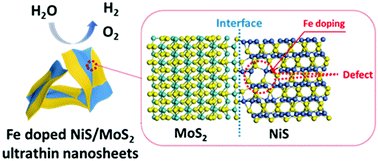Defect-rich Fe-doped NiS/MoS2 heterostructured ultrathin nanosheets for efficient overall water splitting†
Abstract
With the demand for efficient hydrogen/oxygen evolution reaction (HER/OER) bifunctional electrocatalysts, defect-rich two-dimensional (2D) heterostructured materials attract increasing attention due to abundant active sites and facile mass/charge transfer. However, precise manipulation of lattice defects in a 2D heterostructured material is still a challenge. Herein, through pyrolytic sulfurization of a layered Fe-doped Ni/Mo MOF precursor, a series of defect-rich Fe-doped NiS/MoS2 ultrathin nanosheets were obtained. For 0.1Fe-NiS/MoS2, abundant lattice defects induced by Fe atoms provide more water adsorption sites, and intimate interface between NiS and MoS2 can optimize the adsorption energy of a HER/OER intermediate. As a result, both HER and OER activities are significantly enhanced. The respective overpotential is 120 mV and 297 mV for the HER and OER. Small Tafel slopes of 69.0 mV dec−1 and 54.7 mV dec−1 indicate favorable electrochemical reaction kinetics. The catalytic performance of this material can be compared with those of 20% Pt/C and RuO2 catalysts and top-rated MoS2-based materials. For overall water splitting, only 1.66 V voltage is required to deliver 10 mA cm−2. Long-term stability of 0.1Fe-NiS/MoS2 presents a prospect for its practical application.



 Please wait while we load your content...
Please wait while we load your content...